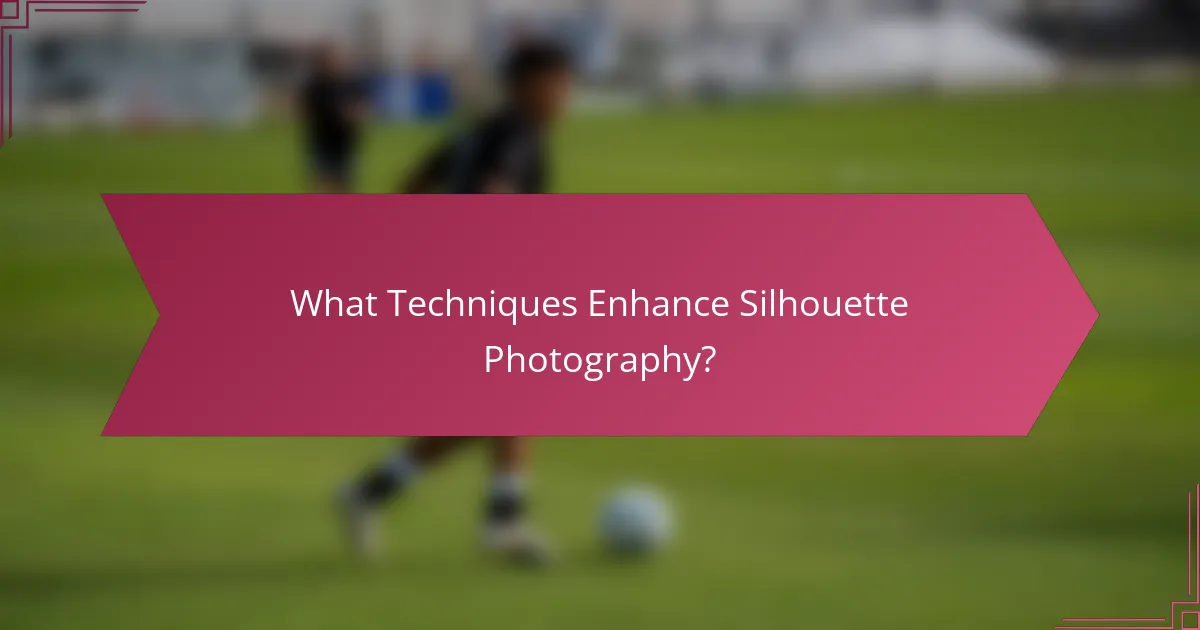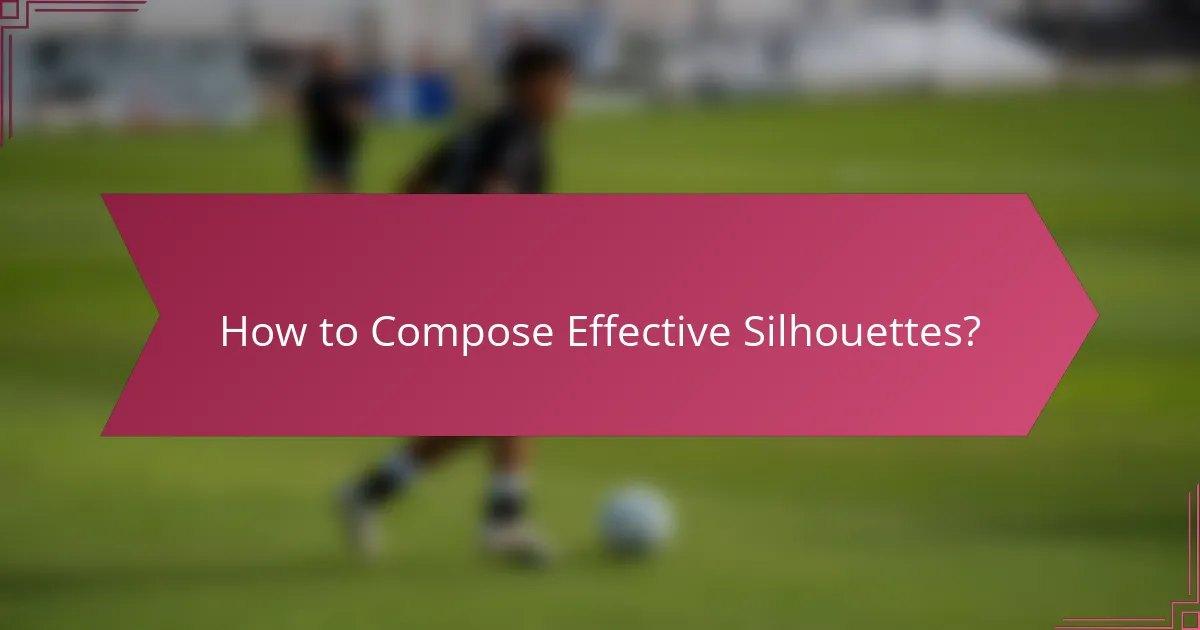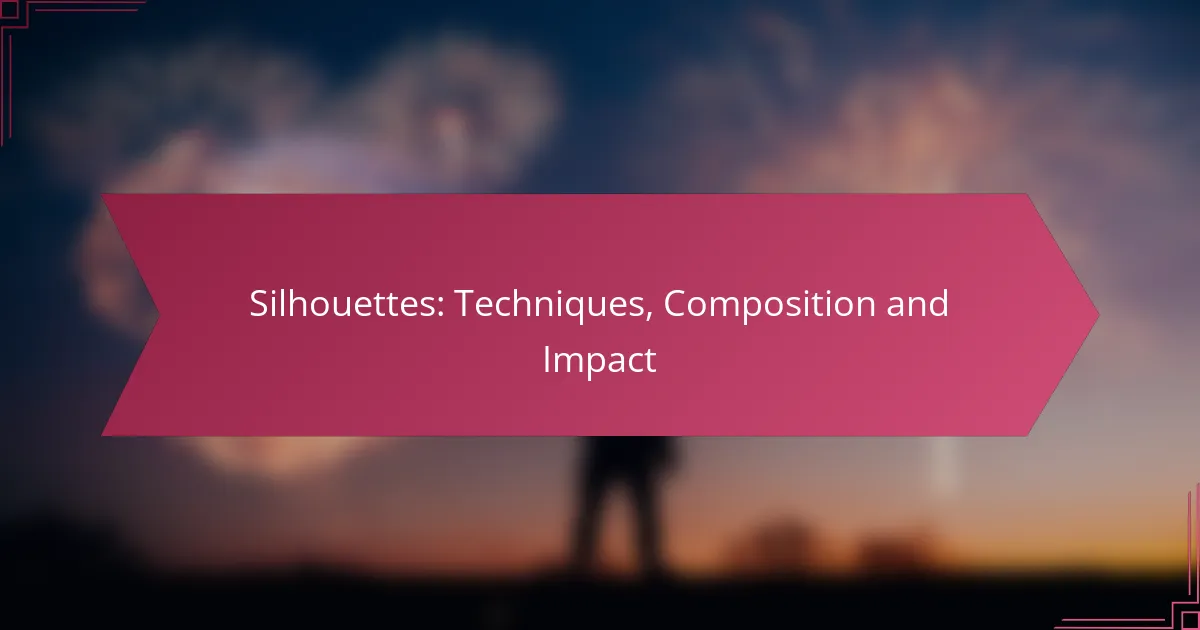Silhouette photography is a captivating art form that emphasizes the contrast between subjects and their backgrounds, creating striking visual narratives. By employing techniques such as backlighting and high contrast settings, photographers can craft compelling compositions that highlight shapes and forms while obscuring intricate details. This approach not only enhances the aesthetic appeal but also fosters a deeper emotional connection with the viewer.

What Techniques Enhance Silhouette Photography?
To enhance silhouette photography, focus on techniques that emphasize the contrast between the subject and the background. Key methods include using backlighting, high contrast settings, and effective post-processing adjustments.
Backlighting Techniques
Backlighting is crucial for creating striking silhouettes, as it places the light source behind the subject. This technique works best during sunrise or sunset when the sun is low on the horizon, casting a warm glow that outlines the subject. Position your subject so that the light source is directly behind them to achieve a clear silhouette.
Experiment with different angles and distances to find the most compelling composition. Using a wide aperture can help blur the background, enhancing the subject’s outline.
High Contrast Settings
High contrast settings are essential for silhouette photography, as they accentuate the difference between light and dark areas. Use manual settings on your camera to increase the contrast, or adjust the exposure compensation to underexpose the image slightly. This technique helps in rendering the subject as a dark shape against a bright background.
Look for scenes with naturally high contrast, such as a bright sky against a dark landscape, to maximize the silhouette effect.
Silhouette Filters
Silhouette filters can enhance the visual impact of your images during shooting or in post-processing. These filters reduce the brightness of the subject while enhancing the background light, making silhouettes more pronounced. Many photo editing software programs offer filters specifically designed for this purpose.
Consider using gradient filters that darken the top of the frame while keeping the bottom lighter, which can create a more dramatic effect in your silhouettes.
Post-Processing Adjustments
Post-processing is a vital step in silhouette photography to refine the final image. Adjusting the brightness and contrast levels can help emphasize the silhouette further. Use tools like Adobe Lightroom or Photoshop to tweak the exposure, shadows, and highlights, ensuring the subject remains dark while the background pops.
Additionally, consider converting images to black and white for a classic silhouette look, which can enhance the emotional impact of the photograph.
Using Natural Frames
Incorporating natural frames can add depth and context to silhouette photography. Look for elements like trees, archways, or windows that can frame your subject. This technique draws the viewer’s eye directly to the silhouette while providing a sense of place.
When composing your shot, ensure that the framing elements do not overpower the silhouette but rather complement it, enhancing the overall composition.

How to Compose Effective Silhouettes?
To compose effective silhouettes, focus on strong contrasts between the subject and the background, utilizing light and shadow to create a striking visual impact. Consider the arrangement of elements within the frame to enhance the overall composition and draw attention to the subject.
Rule of Thirds Application
The Rule of Thirds is a fundamental guideline in photography that suggests dividing the frame into a 3×3 grid. Positioning your subject along these lines or at their intersections can create a more dynamic and balanced silhouette. For example, placing a tree or person at one of the grid’s intersections can lead to a more engaging composition.
When applying this rule, remember to leave some negative space around the subject. This helps to emphasize the silhouette and can enhance the overall aesthetic of the image.
Foreground and Background Balance
Achieving balance between the foreground and background is crucial in silhouette composition. A cluttered background can distract from the subject, while a simple, unobtrusive background can enhance the silhouette’s clarity. Aim for a clean backdrop that contrasts well with the subject.
Consider using elements in the foreground to frame the silhouette. For instance, branches or architectural features can add depth and context without overwhelming the main subject.
Subject Placement Strategies
Effective subject placement is key to creating impactful silhouettes. Position your subject against a light source, such as a sunset or bright sky, to ensure a strong contrast. Experiment with different angles and distances to find the most compelling perspective.
Additionally, varying the height and orientation of the subject can significantly affect the silhouette’s impact. For example, a person standing tall against a sunset will create a different visual effect than someone crouching. Always consider how the subject’s posture and position contribute to the overall composition.

What Impact Do Silhouettes Have in Visual Storytelling?
Silhouettes play a crucial role in visual storytelling by emphasizing shapes and forms while obscuring details. This technique allows for a powerful emotional connection and can convey complex narratives through simple imagery.
Emotional Engagement
Silhouettes evoke strong emotional responses by stripping away extraneous details, allowing viewers to project their feelings onto the image. The absence of facial expressions or specific features invites interpretation, making the viewer’s emotional engagement more personal and profound.
For instance, a silhouette of a person standing alone against a sunset can evoke feelings of loneliness or contemplation. By focusing on the outline rather than the details, the image resonates on a deeper emotional level.
Focus on Subject Matter
Using silhouettes directs attention to the subject matter without distractions. This technique highlights the essence of the subject, making it easier for the audience to grasp the main idea or theme being conveyed.
For example, in a narrative about freedom, a silhouette of a bird in flight can effectively symbolize liberation. By emphasizing the shape of the bird, the viewer can immediately understand the concept without needing additional context.
Creating Mystery and Intrigue
Silhouettes inherently create a sense of mystery by concealing details that could provide clarity. This ambiguity encourages viewers to ponder the story behind the image, fostering curiosity and deeper engagement.
A silhouette of a figure standing at the edge of a cliff can provoke questions about who they are and what they are contemplating. This intrigue can draw viewers into the narrative, prompting them to explore the visual story further.

What Are the Best Tools for Silhouette Photography?
The best tools for silhouette photography include a camera with manual settings, a suitable lens, and editing software to enhance the final image. These tools help create striking contrasts between the subject and the background, emphasizing shapes and outlines.
Camera Settings for Silhouettes
To capture effective silhouettes, set your camera to manual mode. Use a low ISO setting, typically around 100 or 200, to minimize noise, and adjust the aperture to a wider setting, like f/8 to f/16, to ensure a sharp focus on your subject.
Meter for the background light rather than the subject to achieve the desired dark effect. A shutter speed of 1/100 to 1/500 seconds usually works well, depending on the lighting conditions.
Recommended Lenses
For silhouette photography, prime lenses with a focal length of 35mm to 85mm are often recommended due to their sharpness and ability to create beautiful bokeh. A wide-angle lens can also be effective for capturing expansive scenes.
Consider using a lens with a larger aperture, such as f/1.8 or f/2.8, to create a shallow depth of field, which helps isolate the subject against the background.
Editing Software Options
Popular editing software for enhancing silhouette images includes Adobe Lightroom and Photoshop, which offer powerful tools for adjusting contrast and exposure. These programs allow you to refine the silhouette effect by darkening the subject further and enhancing the background.
Free alternatives like GIMP or online tools such as Canva can also be effective for basic adjustments. Focus on increasing contrast and possibly adding a gradient to the background to make the silhouette stand out more prominently.

What Are the Common Mistakes in Silhouette Photography?
Common mistakes in silhouette photography often stem from poor planning and execution. These errors can lead to unappealing images that fail to capture the intended dramatic effect.
Improper Lighting Conditions
Lighting is crucial in silhouette photography, as it defines the subject against the background. The best conditions typically occur during sunrise or sunset when the light is soft and warm, creating a striking contrast.
Avoid shooting in harsh midday sunlight, which can wash out details and diminish the silhouette effect. Instead, aim for low-angle light that enhances the outlines of your subjects, ensuring they stand out against the bright background.
To achieve optimal results, consider using reflectors or diffusers to manipulate light. This can help create more defined edges and improve the overall quality of your silhouette images. Always check your camera settings to ensure proper exposure, as this can significantly impact the final outcome.
